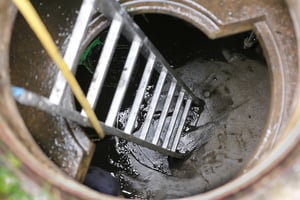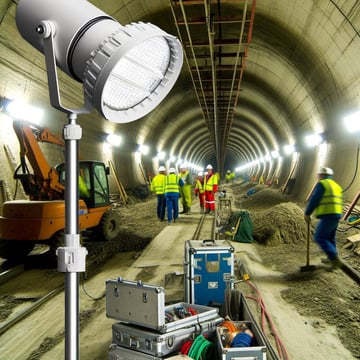 When you hear someone talking about working in a "confined space," that doesn't just mean that they are working in tight quarters. "Confined space entry" is actually a tightly (pun intended) defined term that comes with a certain set of safety requirements for personnel.
When you hear someone talking about working in a "confined space," that doesn't just mean that they are working in tight quarters. "Confined space entry" is actually a tightly (pun intended) defined term that comes with a certain set of safety requirements for personnel.
In order for an area to be called a confined space, it needs to meet all 3 of the following criteria:
- Large enough for personnel to perform work
- Limited openings for entry and exit
- Not intended for continuous human occupancy
Examples of these types of spaces include tanks, vessels, manholes, silos, storage bins, hoppers, vaults, and pits.
But "confined space" is not a one-size-fits-all term. Depending on the conditions within the space, there are further definitions and, therefore requirements, that must be adhered to.
In order to better understand this, we’ve highlighted a number of confined spaces and the requirements that define them below:
- Permit-Required - A confined space that requires a permit if it has one of the following characteristics below. The safety department of the company is required to have this permit system that ensures the area is safe when entered, and informs all parties of maintenance times including all operators are aware of who is inside and that equipment is shut off.
- Contains or has a potential to contain a hazardous atmosphere.
- Contains a material that has the potential for engulfing the entrant.
- Has an internal configuration such that an entrant could be trapped or asphyxiated by inwardly converging walls or by a floor which slopes.
- Contains any other recognized serious safety or health hazard/s.
- Non-Permit Required - a confined space that does not contain or, with respect to atmospheric hazards, have the potential to contain any hazard capable of causing death or serious physical harm. If a place is free of a hazard, then an entry permit isn’t required.
- No-Entry Confined Space - A space where workers are not allowed to enter.
- Hazardous Atmospheres - An atmosphere which poses a danger to both the location/equipment and persons entering. Hazardous Atmospheres can be defined as:
- Flammable – known as enriched oxygen atmospheres, vaporization of flammable liquids, chemical reactions, and concentration of combustible dust or absorption of chemicals from inner surfaces of the confined space.
- Toxic - Entire spectrum of gases, vapors, and air-borne dusts. Some examples of toxic atmospheres are manufacturing processes such as charcoal, product storage such as removal of a substance from a tank or maintenance work such as welding in a confined space.
- Irritant/Corrosive - Normally these types of atmospheric hazards are divided into primary and secondary groups.
- Primary irritants exert no systemic toxic effects because the products formed by them on tissues of the respiratory tract are non-irritant and other irritant effects are so violent as to obscure any systemic toxic action. Examples are chlorine, ozone, hydrochloric acid, etc.).
- Secondary irritants may produce systemic toxic effects in addition to surface irritation. In most cases, the worker is not aware of any increase in the exposure to these hazardous toxic substances.
- Asphyxiating – Deficiency in of the proper amount of Oxygen. Reduction of oxygen in a confined space may be the result of either consumption or displacement.
- Ventilation - OSHA does not define the amount of air exchanges required (some states offer requirements for this), but the typical rule is to have at least 5 complete air exchanges per hour.
For more information about confined spaces and the requirements surrounding them, visit the OSHA website.
Ericson has been a leader in confined space entry safety for decades. Download our Confined Space Solutions Guide to learn more about how Ericson can make your job site safer.
More from the blog
View All Posts
Wiring Devices
7 min read
| December 5, 2024
Selecting Commercial and Industrial Wiring Device for your Application
Read More
Workplace Safety
17 min read
| August 20, 2024
Industrial Grade Job site Lighting Solutions for Confined Spaces
Read More
Workplace Safety
2 min read
| June 12, 2024
Protecting Workers and Cords From Harm, Safety Through Compliance
Read MoreSubscribe to blog updates
Stay up-to-date on what's happening at this blog and get additional content about the benefits of subscribing.
